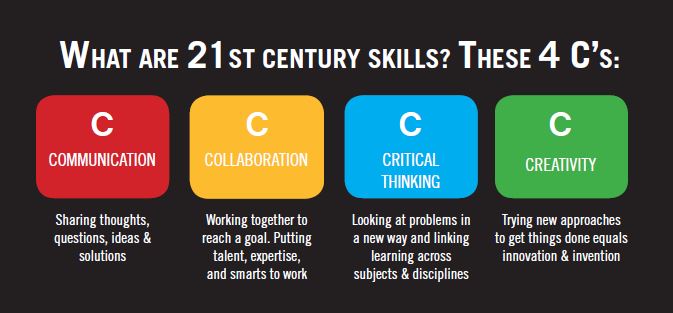Integrating Theory into Practice
In this week, we have learned about 4 subtopics which are Instructional Models, Bloom's Digital Taxonomy, The 4 C's and Multiple Intelligences.
1) Instructional Models
Firstly, we have learned technology integration strategies based on learning theories. There are 6 theories which are Cognitive Information Processing (CIP) Theory, Schema Theory, Cognitive Load Theory, Situated Learning Theory, Gagne’s Theory of Instruction and Constructivism Theory.
- Cognitive Information Processing (CIP) Theory
- This is not one single theory but a generic term used to describe all the perspectives that focus how our cognitive processes such as attention, perception, encoding, storage, and retrieval of knowledge. It uses a two store model where stimuli enter the Sensory Register and from there go to Short Term Memory. Here through rehearsal and encoding they can get stored in Long Term memory. The retrieval process can access this information from LTM and bring it to the Working Memory for use. The model is much like that of a computer.
- Perception
- Perception is how we make meaning of our sensory inputs. Gestalt theory identified that “subjective experiences cannot be explained by referring to objective elements involved” Schunk, D. H. (2008) p142.Gestalt theory suggests we organise our perceptions using general principles eg figure-ground, proximity, similarity, common direction, simplicity (see Schunk, D. H. (2008) p143-145)
- Below is an example of how our perception of an object versus objective reality. This is a static picture, but our minds identify depth.
- Sensory Memory
- We receive a variety of inputs through our senses. CIP suggests that each of these are held in their own register, but only for micro seconds and then only some inputs are transferred to the short term memory. Importantly each sensory registrar works in parallel and do not interfere with each other.
- Short term memory
- This is also called working memory. it is limited in:
- Duration - 15-30 seconds
- Capacity - 7 +/- 2 items.
- Working memory capacity can be determined by:
- Forgetting
- Several mechanisms have been proposed for why we forget information in working memory, and why tasks become harder the more separate elements we need to hold in mind simultaneously. Causes postulated for “forgetting” include limited activation resources, time-based decay, interference due to confusion between items (“crosstalk”). Oberauer and Kliegl (2001,2006) suggest that the best model for understanding forgetting is interference due to overwriting of representations.
- Preventative measures
- Two mechanism that improve capacity include:
- articulatory rehearsal
- attention-based refreshing
- linkage to related information in long term memory
- Long term memory
- Unlike short term memory (working memory) long term memory has:
- Unlimited capacity
- Permanent storage - which can be activated when cued
- Concepts related to long term memory include:
- Declarative vs. procedural. Knowing facts versus knowing "how to”
- Declarative knowledge can be broken into
- episodic memory - linked with events, places, times
- semantic memory - general knowledge and concepts.
- Verbal and visual representation in memory. Words that have an image are more likely to be remembered than abstract words.
- Encoding. The laying down of LTM is facilitated by encoding through organisation, elaboration (a form of rehearsal which takes time), meaningfulness, links with schema.
- Retrieval. The best retrieval cues are the same as the ones used when the material was encoded.
- Practical Implications of CIP for instrucitonal design
- On a practical note Mayer 2003 has identified how this understanding of CIP - parallel sensory inputs, short and long term memory - can be used effectively in elearning instructional design. For example:
- Modality effect - better transfer of information from animation and narration on screen than animation and on-screen text (two parallel different sensory inputs versus two similar sensory inputs)
- Contiguity effect - better transfer when narration and animation are presented simultaneously rather than successive.
- Pearson Education has developed PQ4R teaching process for learners that is based on CIP principles (and used a mnemonic to help the learner remember the steps!)
- Preview
- Question.
- Read.
- Reflect on the material.
- Recite.
- Review.
- What practical implications can you see for using your understanding of CIP in your own education setting?
- Some examples include:
- Provide organized instruction. eg concept maps
- Link new material with prior knowledge.
- Recognize the limits of the sensory register. Create processes to highlight the most important points.
- Recognize the limitations of short-term memory. Use the concept of chunking, elaboration and multiple contexts.
- Match encoding strategies with the material to be learned. eg. combine verbal and images, use mneumonics.
- Create practice opportunities. Allow the learner to generalise concepts and apply it outside of the original learning situation.
- Don’t teach similar and confusing concepts too close together in time.
- use different methods to teach similar concepts
- Encourage "self-regulation" in your learners.
2. Bloom's Digital Taxonomy
3. The 4 C's
4. Multiple
Intelligences
Mayer, R. A. (2003). Elements of a science of e-learning. Journal of Educational Computing Research, 29(3), 297-313. Library Portal Access.https://www.vista.ubc.ca/webct/urw/lc5116011.tp0/cobaltMainFrame.dowebct
K Oberaauer’s website outlines his research on working memory and also includes some interesting research on reasoning.
http://seis.bris.ac.uk/~psxko/
http://www.indiana.edu/~p540alex/unit3.html
http://wps.ablongman.com/ab_slavin_edpsych_8/0,11117,2547913-,00.htm




Comments
Post a Comment